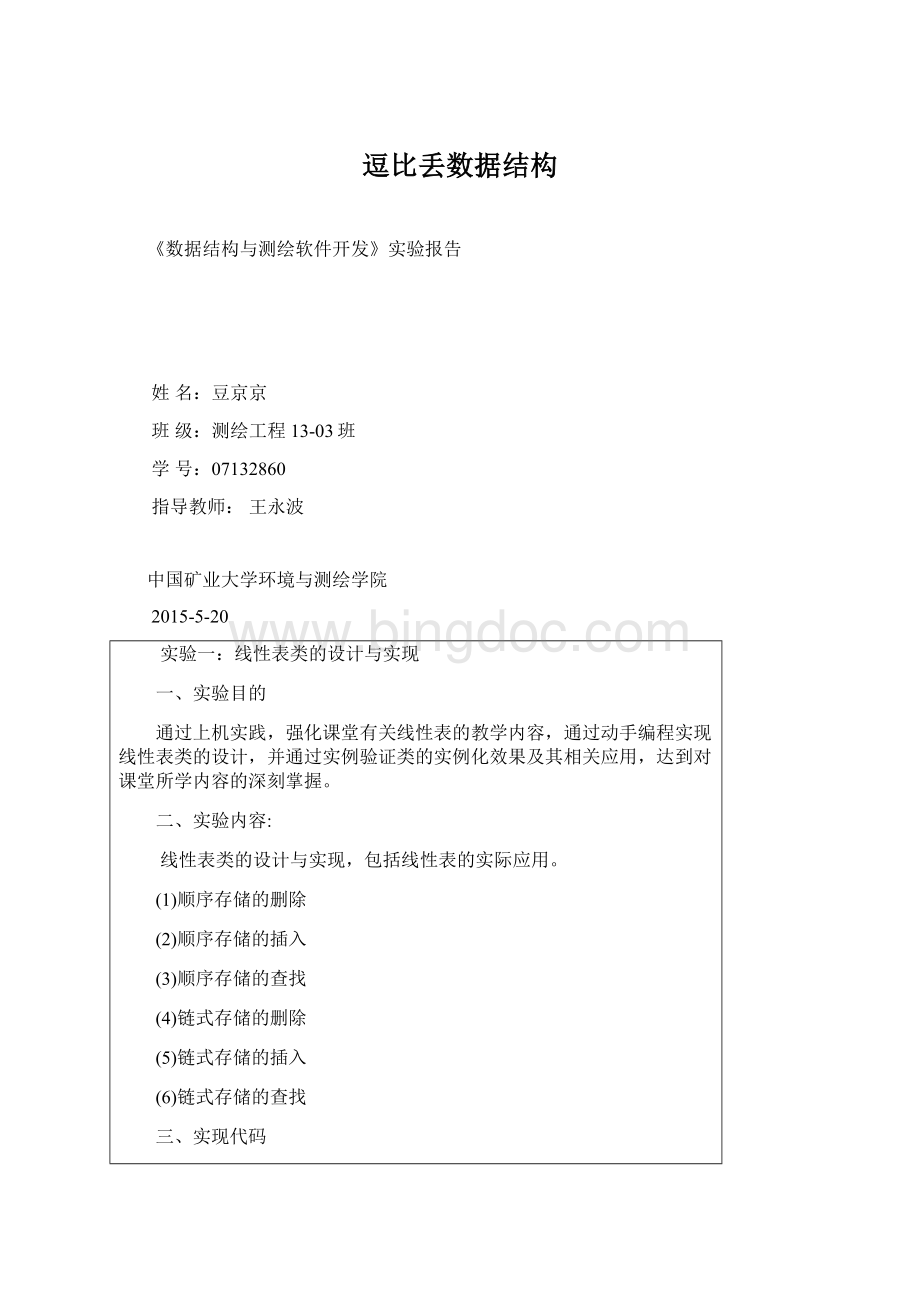逗比丢数据结构.docx
《逗比丢数据结构.docx》由会员分享,可在线阅读,更多相关《逗比丢数据结构.docx(30页珍藏版)》请在冰点文库上搜索。

逗比丢数据结构
《数据结构与测绘软件开发》实验报告
姓名:
豆京京
班级:
测绘工程13-03班
学号:
07132860
指导教师:
王永波
中国矿业大学环境与测绘学院
2015-5-20
实验一:
线性表类的设计与实现
一、实验目的
通过上机实践,强化课堂有关线性表的教学内容,通过动手编程实现线性表类的设计,并通过实例验证类的实例化效果及其相关应用,达到对课堂所学内容的深刻掌握。
二、实验内容:
线性表类的设计与实现,包括线性表的实际应用。
(1)顺序存储的删除
(2)顺序存储的插入
(3)顺序存储的查找
(4)链式存储的删除
(5)链式存储的插入
(6)链式存储的查找
三、实现代码
实现代码:
#include"stdafx.h"
#include
usingnamespacestd;
//类声明
//顺序存储线性表
classCSeqList
{public:
//构造、析构函数
CSeqList();
CSeqList(intsize);
~CSeqList();
public:
//复制构造函数、赋值运算
CSeqList(constCSeqList&sl);
CSeqList&operator=(constCSeqList&sl);
public:
//友元函数
friendostream&operator<<(ostream&os,CSeqList&sl);
public:
//成员函数
intLength()const;
intRemove(intz);//删除
intFind(intx);//查找
intLocate(inti)const;//定位
intInsert(int&x,inti);//插入
intRemove(int&x);//删除
intNext(int&x);//后继
intPrior(int&x);//前驱
intIsEmpty();
intIsFull();
intGet(inti);//提取
voidinnt(intcursize);
public:
//成员变量
int*_data;
int_curSize;
int_maxSize;
};
//类实现
CSeqList:
:
CSeqList()
{
}
CSeqList:
:
CSeqList(intsize)
:
_maxSize(size)
_curSize(0)
{_data=newint[size];
innt(10);
}
CSeqList:
:
~CSeqList()
{if(_maxSize>0)
delete[]_data;
}
voidCSeqList:
:
innt(intcursize)
{for(inti=0;i_data[i]=i*100;
_curSize=cursize;
}
intCSeqList:
:
Length()const
{for(inti=0;i<_curSize;i++)
cout<<_data[i]<<"";
cout<return_curSize;
}
intCSeqList:
:
Insert(int&x,inti)//插入
{//元素移动
for(intj=_curSize-1;j>=i;j--)
{_data[j+1]=_data[j];
}
_data[i]=x;
_curSize++;
for(intk=0;k<_curSize;k++)
cout<<_data[k]<<"";
cout<return0;
}
intCSeqList:
:
Remove(intz)//删除
{for(intj=z;j<=_curSize;j++)
_data[j]=_data[j+1];
_curSize--;
for(intg=0;g<_curSize;g++)
cout<<_data[g]<<"";
cout<return0;
}
intCSeqList:
:
Find(intx)//查找
{for(intj=0;j<_maxSize;j++)
if(_data[j]==x)
{cout<return0;
}
cout<<;
return-1;
}
ostream&operator<<(ostream&os,CSeqList&sl)
{
for(inti=0;i{
cout<cout<}
returnos;
}
//类声明
template
classSeqList{
//顺序表存储数组
Type*data;
//最大允许长度
intMaxSize;
//当前最后元素下标
intlast;
public:
SeqList(intMaxSize=defaultSize);
~SeqList(){delete[]data;}
public:
//友元函数
intfriendoperator<<(ostream&os,SeqList&sl);
public:
intLength()const
{returnlast+1;
}
//查找
intFind(Type&x)const;
intLocate(inti)const;//定位
intInsert(inti,Type&x);//插入
intRemove(inti);//删除
intNext(Type&x);//后继
intPrior(Type&x);//前驱
intIsEmpty(){returnlast==-1;}
intIsFull()
{returnlast==MaxSize-1;
}
TypeGet(inti){//提取
returni<0||i>last?
NULL:
data[i];
}
};
//类实现
//类声明
//链式存储线性表
structSLNode{
intdata;//数据域
structSLNode*prior;//指针域
structSLNode*next;//指针域
};
classCLinkedList{
public:
//构造、析构函数
CLinkedList(void);
~CLinkedList(void);
public:
//复制构造函数、赋值运算
CLinkedList(constCLinkedList&sl);
CLinkedList&operator=(constCLinkedList&sl);
public:
//友元函数
intfriendoperator<<(ostream&os,CLinkedList&ll);
public:
//成员函数
intlength()const;
intsearch(int&x)const;//查找
intinsert(int&x,inti);//插入
intremove(int&x);//删除
voidsort();//排序
intisEmpty();
voidsetNull();//置空
intget(inti);//提取
voidoutput();
private:
//成员变量
SLNode*head;
int_size;
};
CLinkedList:
:
CLinkedList()
:
head(NULL)
_size(0)
{
}
CLinkedList:
:
~CLinkedList()
{
}
intCLinkedList:
:
length()const
{return_size;
}
intCLinkedList:
:
search(int&x)const
{if(NULL==head)
return-1;
intresult=1;
SLNode*cur;
cur=head;
while(cur!
=NULL)
{if(cur->data==x)
returnresult;
else
{cur=cur->next;
result++;
}
}
return-1;
}
intCLinkedList:
:
insert(int&x,inti)
{if(i<=0)//越界
return-1;
if(_size==0)
{//插入结点操作
SLNode*temLN=newSLNode();
temLN->data=x;
temLN->next=NULL;
head=temLN;
_size++;
return1;
}
elseif(i>_size)//在链表尾部插入
{SLNode*cur=head;
while(cur->next!
=NULL)
cur=cur->next;
//插入结点操作
SLNode*temLN=newSLNode();
temLN->data=x;
temLN->next=NULL;
cur->next=temLN;
_size++;
return1;
}
SLNode*cur=head;
for(intk=1;k{cur=cur->next;
}
//插入结点操作
SLNode*temLN=newSLNode();
temLN->data=x;
temLN->next=cur->next;
cur->next=temLN;
_size++;
return1;
}
intCLinkedList:
:
remove(int&x)
{SLNode*cur=head;
if(cur->data==x)//删除表头第一个元素
{head=cur->next;
return1;
}
//删除除表头之外的其他位置元素
while(cur->next!
=NULL)
{if(cur->next->data==x)//执行删除操作
{cur->next=cur->next->next;
return1;
}
cur=cur->next;
}
return1;
}
intCLinkedList:
:
isEmpty()
{if(_size==0||head==NULL)
return1;
return0;
}
voidCLinkedList:
:
setNull()
{_size=0;
head=NULL;
}
intCLinkedList:
:
get(inti)
{if(i<=0||i>_size)
{cout<<"下表越界!
"<return0;
}
SLNode*cur=head;
for(intk=1;k{cur=cur->next;
}
returncur->data;
}
voidCLinkedList:
:
output()
{SLNode*cur;
cur=head;
while(cur!
=NULL)
{cout<data<<"";
cur=cur->next;
}
cout<}
intmain(intargc,char*argv[])
{
/*CSeqListsl(100);
intlen=sl.Length();
cout<cout<inty=1000;
intp=2330;
sl.Insert(y,5);
sl.Remove(6);
sl.Find(p);
*/
CLinkedListmyList;
for(inti=1;i<=12;++i)
{myList.insert(i,i);
}
cout<<"输出遍历结果:
"<myList.output();
cout<<"删除第个元素:
"<intx=9;
myList.remove(x);
//遍历
myList.output();
cout<<"在第个元素位置处插入一个:
"<x=20;
myList.insert(x,5);
//遍历
myList.output();
return0;
}
四、算法测试数据及其运行结果
五、实验小结(问题及心得)
(1)学会了线性表的基本应用,掌握了线性表的基本概念;
(2)掌握了VC++软件的应用,初步掌握了编写程序的基本步骤;
(3)掌握了线性表的实际用途。
实验二:
线性表类的设计与实现
一、实验目的
通过上机实践,强化课堂有关线性表的教学内容,通过动手编程实现线性表类的设计,并通过实例验证类的实例化效果及其相关应用,达到对课堂所学内容的深刻掌握。
二、实验内容
利用C++语言编程实现二叉树的构建及其先序、中序、后序遍历算法.
(1)二叉树的构建
(2)二叉树的先序遍历算法及其实现
(3)二叉树的中序遍历算法及其实现
(3)二叉树的后续遍历算法及其实现
三、实现代码
实现代码:
#include
#include
usingnamespacestd;
typedefstructBTNode
{intdata;
BTNode*lChild;
BTNode*rChild;
}SBTNode;
classCBinTree
{public:
CBinTree();
~CBinTree();
voidcreateBSTree(vector&xArray);
voidinsertNode(SBTNode*&temNode,BTNode*&root);
voidInOrder(BTNode*&root);//中序遍历
voidPreOrder(BTNode*&root);//先序遍历
voidPostOrder(BTNode*&root);//后序遍历
public:
BTNode*root;
vectorxArray;
};
CBinTree:
:
CBinTree()
:
root(NULL)
{
}
CBinTree:
:
~CBinTree()
{xArray.clear();
}
voidCBinTree:
:
createBSTree(vector&xArray)
{for(vector:
:
iteratoriter=xArray.begin();
iter!
=xArray.end();++iter)
{BTNode*temNode=newBTNode;
temNode->data=*iter;
temNode->lChild=NULL;
temNode->rChild=NULL;
insertNode(temNode,root);
}
}
voidCBinTree:
:
insertNode(SBTNode*&temNode,BTNode*&root)
{if(root==NULL)
root=temNode;
else
{if(temNode->data>root->data)
insertNode(temNode,root->rChild);
else
insertNode(temNode,root->lChild);
}
}
voidCBinTree:
:
InOrder(BTNode*&root)
{if(root==NULL)
return;
InOrder(root->lChild);
cout<data<<"";
InOrder(root->rChild);
}
voidCBinTree:
:
PreOrder(BTNode*&root)
{if(root==NULL)
return;
cout<data<<"";
PreOrder(root->lChild);
PreOrder(root->rChild);
}
voidCBinTree:
:
PostOrder(BTNode*&root)
{if(root==NULL)
return;
PostOrder(root->lChild);
PostOrder(root->rChild);
cout<data<<"";
}
int_tmain(intargc,_TCHAR*argv[])
{vectorxArray;
xArray.push_back(11);
xArray.push_back(19);
xArray.push_back(3);
xArray.push_back(8);
xArray.push_back(13);
xArray.push_back
(2);
xArray.push_back(7);
CBinTreeBT;
BT.createBSTree(xArray);
BT.InOrder(BT.root);
cout<BT.PreOrder(BT.root);
cout<BT.PostOrder(BT.root);
cout<return0;}
四、算法测试数据及其运行结果
五、实验小结(问题及心得)
(1)学会了二叉树的基本应用,掌握了二叉树的基本概念;
(2)掌握了二叉树的实际用途。
实验三:
线性表类的设计与实现
一、实验目的
通过上机实践,强化课堂有关线性表的教学内容,通过动手编程实现线性表类的设计,并通过实例验证类的实例化效果及其相关应用,达到对课堂所学内容的深刻掌握。
二、实验内容
1)图的创建
2)基于深度优先的图的遍历算法的设计与实现
3)基于广度优先的图的遍历算法的设计与实现
4)基于Prim算法的最小生成树的构建
5)基于Kruskal算法的最小生成树的构建
三、实现代码
实现代码:
#include"stdafx.h"
#include
#include
#include
#include
#include
usingnamespacestd;
//用于存储图的节点及其相邻节点的结构体变量类型
structSGNode{intkey;//结点自身标识
mapneighNodes;//与当前结点相邻的结点集合,及其与相邻结点之间路径的权值
};//用于存储边的结构体变量类型
structSGEdge{intstart;
intend;
};//用于存储边及其权重的map容器(注意:
会按照权重自小而大自动排序)
typedefmapEdgeSet;
classCMyGraph
{public:
CMyGraph(void);
~CMyGraph(void);
public:
//其他函数,供实例调用
voidDFS();
voidDFS(inti,vector&mystack,bool*visited);
voidBFS();
voidBFS(inti,deque&mydeque,bool*visited);
voidPrim();
voidKruskal();
protected:
//属性变量
private:
//成员变量
vectorNodeSet;
};CMyGraph:
:
CMyGraph(void)
{floatg[7][7]=
{
{0,12,1,0,0,0,4},
{12,0,0,11,0,10,0},
{1,0,0,9,2,0,0},
{0,11,9,0,0,8,0},
{0,0,2,0,0,5,3},
{0,10,0,0,0,7,6},
{0,0,0,8,5,7,0},
};for(inti=0;i<8;i++)
{SGNodesg;
sg.key=i;
NodeSet.push_back(sg);
}for(intm=0;m<8;m++)
{for(intn=0;n<8;n++)
{if(g[m][n]!
=0)
{NodeSet[m].neighNodes.insert(map:
:
value_type(n,g[m][n]));
}
}
}vector:
:
iteratoriter;
for(iter=NodeSe